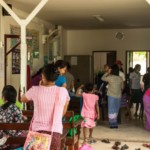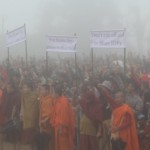By Feliz Solomon / Democratic Voice of Burma (DVB) | August 12, 2016
Few people are familiar with the tragic story of thousands of ethnic Mon refugees who were forced to flee Burma in 1990, only to be returned a few years later as war raged on in their native state. Just a few months after they were repatriated, one of their three relocation sites came under attack by the Burmese army, sending some 6,000 people pouring back over the border into Thailand.
The Thai government, which had already expelled the refugees, reportedly pushed again for their removal and cut off crucial aid supplies. A new report penned by a consortium of rights groups details this forgotten episode, as plans progress to begin assisting the return of refugees that remain in camps along the border.
Invisible Lives: The Untold Story of Displacement Cycle in Burma, frames the Mon refugee experience as a cautionary tale, whereby thousands of conflict-affected people were shuttled back and forth between two unwelcoming territories. Decades later, they remain displaced, disadvantaged, lacking land rights and sources of income, and still deeply distrustful of authorities.
“More than 20 years since Mon refugees were repatriated to Burma, the vast majority remain displaced and have not found a durable livelihood solution,” the report said, citing remote locations and few work opportunities as contributors to their prolonged poverty and exclusion.
“The impact and result we hope for is that during the peace process and dialogue, we would like the international community – especially donor agencies – to consider humanitarian assistance to IDPs, especially in Shan, Karen, Mon and Kachin states,” explained Nai Kasauh Mon, director of the Human Rights Forum of Mon State (HURFOM), which produced the report in collaboration with Mae Sot-based NGOs Burma Link and Burma Partnership.
“They need to think about this before repatriation,” he told DVB. “Civil society needs well designed programs to support the refugees and IDPs.”
Decades of conflict have left hundreds of thousands of people in protracted displacement within Burma, while more than 100,000 others still reside in refugee camps along the border with Thailand. For years they have relied on support from community-based organisations, agencies such as UNHCR, and funding provided by international donors. However, priorities have shifted since Burma’s political reform process began in 2011, the report said.
As foreign states embrace Burma’s newly elected leadership, much of the funding that used to be funneled to the border is being redirected through the Burmese government. This centralisation of aid distribution has left some of the most marginalised ethnic communities at a severe disadvantage, according to the authors.
“This shift in aid priorities can be attributed to the normalisation of aid relations between foreign governments and the Burma government,” the report said. “Funds are increasingly aligned with government priorities, as required by key international accords.”
Nai Kasauh called on the international community to remain mindful of the needs of the displaced amid the rapidly changing context of engagement with a new, democratic Burma. Talk has escalated in recent years about beginning to repatriate refugees residing in Thailand, causing concern that those returned could be placed in unsafe or unsustainable conditions.
The UNHCR, the United Nations’ refugee agency, told DVB that it is taking measures to ensure a safe and dignified return for well-informed refugees that choose to go back to Burma.
“In light of the developments in Myanmar
Rochanakorn said UNHCR will involve NGOs, civil society and refugee representatives in its forthcoming talks with state-level governance, and that while voluntary return looks likely to happen, conditions inside some of Burma’s outlying areas do not yet meet the benchmarks for return of refugees en masse.
“UNHCR does not currently assess the overall situation in Myanmar to be conducive to promoting large-scale returns; however, it is a refugee’s fundamental right to return to his or her own country,” she said. “Indeed, an increasing number of refugees have expressed to us their desire to return to Myanmar and have requested our support.”
In such cases where refugees choose to return, UNHCR will help to facilitate if it can confirm the voluntary nature of the request, secure agreement from the government, ensure that there are no ongoing security risks, and access the relocation site to provide follow-up support, she said.
For HURFOM and its partners, concerns about continued support are front and center, having seen what happened to the thousands of displaced Mon villagers after they were repatriated in 1994 and left with little resources. To those providing assistance along the border, today’s context is vastly different, though it will still be difficult to ensure long-term safety and livelihoods for Burma’s conflict-affected peoples.
”This is probably the best opportunity in decades for refugees to return, resettle and reintegrate into Burma, but it will be problematic and there are no guarantees,” said Duncan McArthur, programme director at The Border Consortium, which has provided food and shelter for Thailand’s border camps since 1984. Contrary to popular rumour, McArthur said TBC has seen no sign of pressure from the Thai government to speed up the return of refugees, stating that the current ruling junta “appears keen to wait” until the Burmese government is ready to facilitate a safe return.
This article originally appeared on DVB on August 12, 2016.



![‘The Burma Army Killed Him [Saw O Moo] – At Least the Government or the Army Should Commit to Not Do This Again’: Paul Sein Twa, Executive Director of KESAN](https://www.burmalink.org/wp-content/uploads/2018/05/Saw-O-Moo-commemoration-Paul-Sein-Twa-speaking-2-150x150.jpg)



